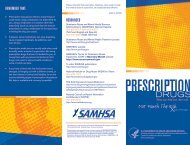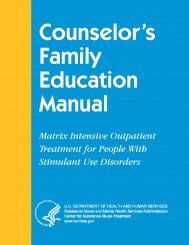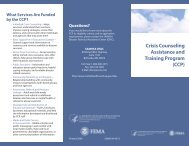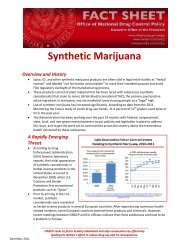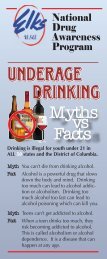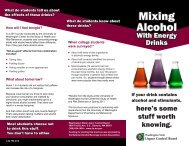Counselor's Manual for Relapse Prevention With Chemically ...
Counselor's Manual for Relapse Prevention With Chemically ...
Counselor's Manual for Relapse Prevention With Chemically ...
You also want an ePaper? Increase the reach of your titles
YUMPU automatically turns print PDFs into web optimized ePapers that Google loves.
e. The leader should encourage the group to question the patient on the probability of theoutcomes. The patient should reevaluate any unrealistic expected outcomes.Exercise No. 22: Challenging InjunctionsPurpose. This exercise allows the patient to take the in<strong>for</strong>mation about injunctions obtained fromthe group and identify different ways to handle the injunctions in the future.Instructions. The patient should read the injunction, realize other ways that he or she can thinkinstead, and state what he or she thinks the possible outcomes of thinking in these ways wouldbe. The group should be encouraged to question the patient on the probability of the outcomes.The patient should reevaluate any unrealistic expected outcomes.Exercise No. 23: Improved Reactions to Mandates and InjunctionsPurpose. This exercise helps the patient find new ways to handle those mandates and injunctionsthat are true and create situations where the patient does not see alternative reactions.Instructions. Have the patient read aloud in group the mandates and injunctions, the alternativebehavior, and the possible outcomes of both scenarios. Ask the group members to question thelikelihood of the patient being able to carry out the alternative, the reality of the outcomes of thisplan. The group should then ask what skills the patient must gain and what tasks he she mustcomplete in order to carry out this plan.Exercise No. 24: Management of High-Risk SituationsPurpose. Exercise No. 24 helps the patients to pull together all the material that has been workedon so far. Critical high-risk situations that were identified in Exercise No. 17, part 5, areanalyzed. The patient then describes different ways of handling the high-risk situations. Thepatient also lists mandates and injunctions that are associated with these high-risk situations.Instructions. The patient makes four copies of the exercise to fill out, one <strong>for</strong> each of the fourhigh-risk situations identified in Exercise No. 17, part 5. The group should give feedback to thepatient on the accuracy of the situations and how feasible they think the patient's solutions tohandling high-risk situations are. The group should also give feedback to the patient about themandates and injunctions.Recovery PlanningExercise No. 25: <strong>Relapse</strong> <strong>Prevention</strong> StrategiesPurpose. The purpose of this exercise is to pull together a set of personal relapse preventionstrategies <strong>for</strong> each personal high-risk situation identified. The patient develops one card <strong>for</strong> eachhigh-risk situation. The patient will have four cards if he or she identified four high-risksituations, but some patients may want to develop more cards. The patient starts off each day





